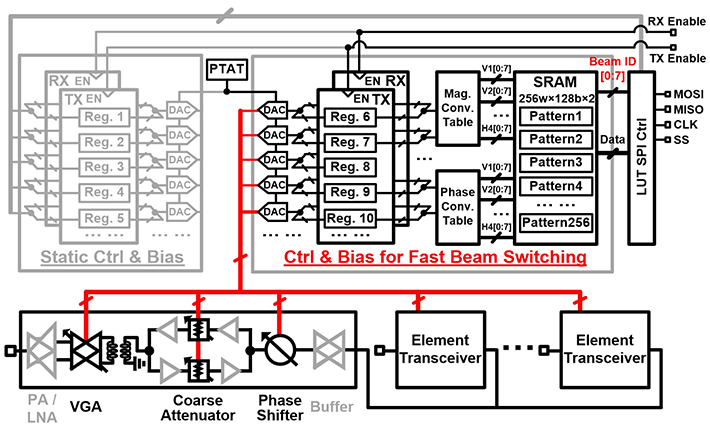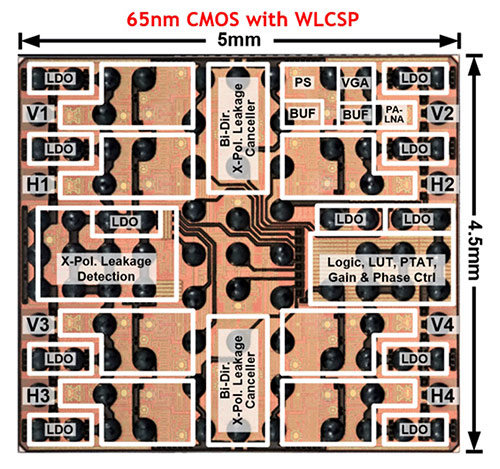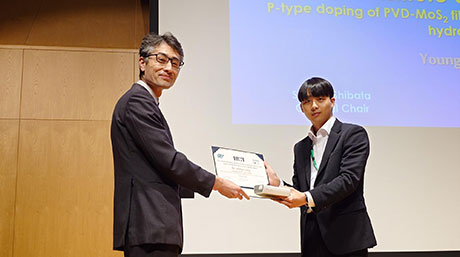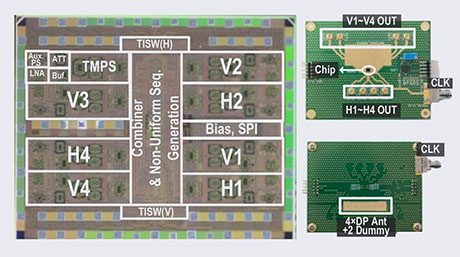Electrical and Electronic Engineering News
Novel Fast-Beam-Switching Transceiver Takes 5G to the Next Level
Scientists at Tokyo Institute of Technology (Tokyo Tech) and NEC Corporation jointly develop a 28-GHz phased-array transceiver that supports efficient and reliable 5G communications. The proposed transceiver outperforms previous designs in various regards by adapting fast beam switching and leakage cancellation mechanism.
With the recent emergence of innovative technologies, such as the Internet of Things, smart cities, autonomous vehicles, and smart mobility, our world is on the brink of a new age. This stimulates the use of millimeter-wave bands, which have far more signal bandwidth, to accommodate these new ideas. 5G can offer data rates over 10 Gbit/s through the use of these millimeter-waves and multiple-in-multiple-out (MIMO) technology—a technology that employs multiple transmitters and receivers to transfer more data at the same time.
Large-scale phased-array transceivers are crucial for the implementation of these MIMO systems. While MIMO systems boost spectral performance, large-scale phased-array systems face several challenges, such as increased power dissipation and implementation costs. One such critical challenge is latency caused by beam switching time. Beam switching is an important feature that enables the selection of the most optimal beam for each terminal. A design that optimizes beam switching time and device cost is, thus, the need of the hour.
Motivated by this, scientists from Tokyo Institute of Technology and NEC Corporation in Japan collaborated to develop a 28-GHz phased-array transceiver that supports fast beam switching and high-speed data communication. Their findings will be discussed at the 2021 Symposia on VLSI Technology and Circuits![]() , an international conference that explores emerging trends and innovative concepts in semiconductor technology and circuits.
, an international conference that explores emerging trends and innovative concepts in semiconductor technology and circuits.
The proposed design facilitates dual-polarized operation, in which data is transmitted simultaneously through horizontal and vertical-polarized waves. However, one issue with these systems is cross-polarization leakage, which results in signal degradation, especially in the millimeter-wave band. The research team delved into the issue and developed a solution. Prof. Kenichi Okada, who led the research team, says, "Fortunately, we were able to devise a cross-polarization detection and cancellation methodology, using which we could suppress the leakages in both transmit and receive mode."
One critical feature of the proposed mechanism is the ability to achieve low-latency beam switching and high-accuracy beam control. Static elements control the building blocks of the mechanism, while on-chip SRAM is used to store the settings for different beams (Figure 1). This mechanism leads to fast beam switching with ultra-low latency being achieved. It also enables fast switching in transmit and receive modes due to the use of separate registers for each mode.

Figure 1. Fast-beam-switching control mechanism
Large volume SRAM and lookup table are used for supporting 256 beam settings. The mechanism supports fast switching in transmit (TX) and receive (RX) mode with direct external TX/RX enable pins.
Another aspect of the proposed transceiver is its low cost and small size. The transceiver has a bi-directional architecture, which allows for a smaller chip size of 5 × 4.5 mm2 (Figure 2). For a total of 256-pattern beam settings stored within the on-chip SRAM, a beam switching time of only 4 nanoseconds was achieved! Error vector magnitude (EVM)—a measure to quantify the efficiency of digitally modulated signals such as quadrature amplitude modulation (QAM)—was calculated for the proposed transceiver. The transceiver was supported with EVMs of 5.5% in 64QAM and 3.5% in 256QAM.

Figure 2. Die micrograph of the proposed transceiver
The proposed phased-array transceiver is fabricated using a 65-nm CMOS process and packaged with wafer-level chip-scale package. It is configured in an area as small as 5 × 4.5 mm.
When compared with state-of-the-art 5G phased-array transceivers, the system has a faster beam switching time and excellent MIMO efficiency. Okada is optimistic about the future of the 28-GHz 5G phased-array transceiver. He concludes, "The technology we developed for the 5G NR network supports high-volume data streaming with low latency. Thanks to its rapid beam switching capabilities, it can be used in scenarios where enhanced multi-user perception is required. This device sets the stage for a myriad of applications, including machine connectivity and the construction of smart cities and factories."
This research is supported by the Ministry of Internal Affairs and Communications in Japan (JPJ000254).
- Reference
| Conference : | 2021 Symposia on VLSI Technology and Circuits |
|---|---|
| Session : | Session 11 Advanced Wireless for 5G, C11-2 (June 17,8:50,JST) |
| Session Title : | A Fast-Beam-Switching 28-GHz Phased-Array Transceiver Supporting Cross-Polarization Leakage Self-Cancellation |
| Authors : | Jian Pang1, Zheng Li1, Xueting Luo1, Joshua Alvin1, Kiyoshi Yanagisawa1, Yi Zhang1, Zixin Chen1, Zhongliang Huang1, Xiaofan Gu1, Weichu Chen1, Yun Wang1, Dongwon You1, Zheng Sun1, Yuncheng Zhang1, Hongye Huang1, Naoki Oshima2, Keiichi Motoi2, Shinichi Hori2, Kazuaki Kunihiro2, Tomoya Kaneko2, Atsushi Shirane1, and Kenichi Okada1,* |
| Affiliations : |
1 Department of Electrical and Electronic Engineering, Tokyo Institute of Technology 2 NEC Corporation |
- Lean and mean: Maximizing 5G communications with an energy-efficient relay network | Tokyo Tech News
- Pushed to the Limit: A CMOS-based transceiver for beyond 5G applications at 300 GHz | Tokyo Tech News
- Greater Connectedness in Remote Areas: A Ka-band Transceiver for Satellite Communications | Tokyo Tech News
- Researchers develop a compact 28-GHz transceiver supporting dual-polarized MIMO | Tokyo Tech News
- Smallest all-digital circuit opens doors to 5 nm next-gen semiconductor | Tokyo Tech News
- A more accurate, low-cost 39 GHz beamforming transceiver for 5G communications | Tokyo Tech News
- Gearing up for 5G: A miniature, low-cost transceiver for fast, reliable communications | Tokyo Tech News
- Tinier and less power-hungry quantum atomic clock push toward intelligent IoT | Tokyo Tech News
- An ultra-low-power frequency synthesizer targeted for IoT devices: Digital PLL achieves a power consumption of 0.265 mW | Tokyo Tech News
- Kenichi Okada - Wiring the world wirelessly | Research Stories | Research
- Okada Lab.
- Researcher Profile | Tokyo Tech STAR Search - Kenichi Okada
- Electrical and Electronic Engineering Graduate Major|Education|Department of Electrical and Electronic Engineering, School of Engineering
- NEC Corporation
- Latest Research News
School of Engineering
—Creating New Industries and Advancing Civilization—
Information on School of Engineering inaugurated in April 2016
Further Information
Professor Kenichi Okada
School of Engineering, Tokyo Institute of Technology
Email okada@ee.e.titech.ac.jp
Tel +81-3-5734-3764






